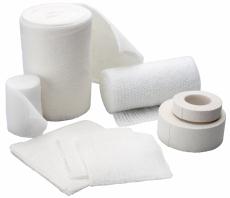An injury is damage to your body. It is a general term that refers to harm caused by accidents, falls, hits, weapons, and more. In the U.S., millions of people injure themselves every year. These injuries range from minor to life-threatening. Injuries can happen at work or play, indoors or outdoors, driving a car, or walking across the street.
Wounds are injuries that break the skin or other body tissues. They include cuts, scrapes, scratches, and punctured skin. They often happen because of an accident, but surgery, sutures, and stitches also cause wounds. Minor wounds usually aren’t serious, but it is important to clean them. Serious and infected wounds may require first aid followed by a visit to your doctor. You should also seek attention if the wound is deep, you cannot close it yourself, you cannot stop the bleeding or get the dirt out, or it does not heal.
Other common types of injuries include
Wounds and Injuries Treatment
Treating wounds and injuries properly is important to prevent infection and promote healing. Here’s a general guide for wound and injury treatment, divided into common types and steps:
Basic Steps for Treating Minor Wounds and Injuries
-
Wash Your Hands
-
Always start with clean hands to avoid infecting the wound.
-
-
Stop the Bleeding
-
Use a clean cloth or bandage and apply gentle pressure.
-
Elevate the area if possible.
-
-
Clean the Wound
-
Rinse with clean water (sterile saline is best).
-
Use mild soap around (not in) the wound.
-
Remove any dirt or debris gently with tweezers sterilized with alcohol.
-
-
Apply an Antibiotic Ointment
-
Use something like Neosporin or a generic antibiotic ointment to prevent infection.
-
-
Cover the Wound
-
Use a sterile bandage or dressing.
-
Change the bandage daily or if it becomes wet/dirty.
-
-
Watch for Infection
-
Signs: Redness, swelling, warmth, pus, increased pain, or fever.
-
If any signs appear, seek medical attention.
-
-
Pain and Swelling Management
-
Use over-the-counter pain relievers like ibuprofen or acetaminophen if needed.
-
Treatment by Wound Type
1. Cuts and Scrapes
-
Clean thoroughly.
-
Keep moist with ointment.
-
Cover and monitor for signs of infection.
2. Puncture Wounds
-
Often deeper and more prone to infection.
-
Clean thoroughly, but do not close the wound immediately—allow drainage.
-
Consider tetanus shot if the wound is deep and you’re not up to date.
3. Burns
-
First-degree (red, non-blistered): Cool the area with running water, apply aloe or burn ointment.
-
Second-degree (blisters): Do not pop blisters. Cool the area, cover loosely, and monitor.
-
Third-degree (charred or white skin): Emergency! Seek immediate medical help.
4. Bruises
-
Ice the area to reduce swelling.
-
Elevate if possible.
-
Rest and avoid re-injury.
5. Sprains and Strains
-
RICE method: Rest, Ice, Compression, Elevation.
-
Use a brace or wrap if needed for support.
When to See a Doctor
-
Deep or large wounds.
-
Excessive bleeding (doesn’t stop after 10 minutes).
-
Signs of infection.
-
Animal or human bites.
-
Objects embedded in the wound.
-
Burns covering large areas or on the face/hands/genitals.
